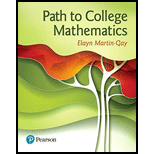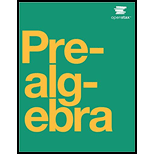
Path To College Mathematics
1st Edition
ISBN: 9780134654409
Author: Martin-Gay, K. Elayn, 1955-
Publisher: Pearson,
expand_more
expand_more
format_list_bulleted
Question
Chapter C, Problem 9ES
To determine
To write
Expert Solution & Answer
Want to see the full answer?
Check out a sample textbook solution
Students have asked these similar questions
10
Using the toddler data from the table in
Question 1 and the appropriate probability
Tonotation, identify and calculate ther s
following:
a. What percentage of the toddlers are
right-handed?
b.
now to
What percentage of the toddlers are
female?
female? da boit vom wo
c. What proportion of the toddlers are
left-handed?
d. What's the chance of finding a male
toddler from the sample?
[10
9
Using the car data from the bumper sticker
table earlier in this chapter and the appro-
priate probability notation, identify and
calculate the following:
a. What percentage of the cars are newer
cars?
b. What's the proportion of older cars?
c. What percentage of the cars have a lot of
bumper stickers?
d. What's the probability that a car doesn't
have a lot of bumper stickers?
Suppose that you roll a single die two times,
and the trials are independent. What is the
chance of rolling two 1s?
Chapter C Solutions
Path To College Mathematics
Ch. C - Prob. 1ESCh. C - Prob. 2ESCh. C - Prob. 3ESCh. C - Prob. 4ESCh. C - Prob. 5ESCh. C - Prob. 6ESCh. C - Prob. 7ESCh. C - Prob. 8ESCh. C - Prob. 9ESCh. C - Prob. 10ES
Ch. C - Prob. 11ESCh. C - Prob. 12ESCh. C - Prob. 13ESCh. C - Prob. 14ESCh. C - Prob. 15ESCh. C - Prob. 16ESCh. C - Prob. 17ESCh. C - Prob. 18ESCh. C - Prob. 19ESCh. C - Prob. 20ESCh. C - Prob. 21ESCh. C - Prob. 22ESCh. C - Prob. 23ESCh. C - Prob. 24ESCh. C - Prob. 25ESCh. C - Prob. 26ESCh. C - Prob. 27ESCh. C - Prob. 28ESCh. C - Prob. 29ESCh. C - Prob. 30ESCh. C - Prob. 31ESCh. C - Prob. 32ESCh. C - Prob. 33ESCh. C - Prob. 34ESCh. C - Prob. 35ESCh. C - Prob. 36ESCh. C - Prob. 37ESCh. C - Prob. 38ESCh. C - Prob. 39ESCh. C - Prob. 40ESCh. C - Prob. 41ESCh. C - Prob. 42ESCh. C - Prob. 43ESCh. C - Prob. 44ESCh. C - Prob. 45ESCh. C - Prob. 46ESCh. C - Prob. 47ESCh. C - Prob. 48ESCh. C - Prob. 49ESCh. C - Prob. 50ESCh. C - 12,000 good assembly line products to 40 defective...Ch. C - Prob. 52ESCh. C - Prob. 53ESCh. C - Prob. 54ESCh. C - Prob. 55ESCh. C - Prob. 56ESCh. C - Prob. 57ESCh. C - Prob. 58ESCh. C - Prob. 59ESCh. C - Prob. 60ESCh. C - Prob. 61ESCh. C - Prob. 62ESCh. C - Prob. 63ESCh. C - Prob. 64ESCh. C - Prob. 65ESCh. C - Prob. 66ESCh. C - Prob. 67ESCh. C - Prob. 68ESCh. C - Prob. 69ESCh. C - Prob. 70ES
Knowledge Booster
Learn more about
Need a deep-dive on the concept behind this application? Look no further. Learn more about this topic, subject and related others by exploring similar questions and additional content below.Similar questions
- wwm popitisie w po qat al miscling s to muroging dW f 19 Satun If you find the joint probabilities for each of the cells in a two-way table, what should they sum to? EXC 61 (antillidsdong isoltitas sbby to combe Sto G1200arrow_forwardSuppose that A and B are complements of each other. Does this mean A and B are mutually exclusive? sbgaimmo Tibbo babad-arrow_forward27 Suppose that A and B are mutually exclusive. Does this mean A and B are independent? ewon) al arods andarrow_forward
- Use Laplace transform to find L{f(t)} f(t) = tsin(t)arrow_forward6 dong mu 2) A Using the toddler data table in Question 1 and appropriate probability notation, identify and calculate the following: a. What percentage of the toddlers are right-handed males? b. What percentage of the toddlers are right-handed females? c. Suppose that you want to see whether you can find a relation between gender and dominant hand. Can you compare your answers to parts a and b to come to a conclusion? d. Find two events in this table that are mutually exclusive. dedorg lenige yewis skilldedang isigys gau eyewis 10 alsublibut to ad sadranarrow_forwardSuppose that medical researchers collect data from an experiment comparing a new drug to an existing drug (call this the treatment variable), regarding whether it made patients' symptoms improve (call this the outcome variable). A check for independence shows that the outcome is related to the treatment the patients receive. a. Are treatment and outcome independent or dependent in this case? b. Do the results mean that the new medi- cine causes the symptoms to improve? Explain your answer.arrow_forward
- Suppose that A and B are independent and P(A) = 0.3 and P(B) = 0.2. Find P(AUB). vob siw bris sugit or sal sarrow_forwardSuppose that you flip a fair coin two times, and the flips are independent. a. What is the probability that you will get two heads in a row? b. What is the probability that you will get exactly one head? c. How does your answer to b change if the chance of a head is 0.75 (coin is not fair)?arrow_forwardSuppose that A and B are independent and P(A)=0.6 and P(B) = 0.2. What is P(A and B)?arrow_forward
- to, and P(BIA) uses the total group general. 13 Using the bumper sticker data from the first example problem in this chapter and appro- priate probability notation, identify and calculate the following: a. Let O = older cars and B = a lot of bumper stickers. Find and interpret P(BIO). b. What percentage of the older cars have a lot of bumper stickers? c. Of the older cars, what percentage have a lot of bumper stickers? d. What's the probability that a car has a lot of bumper stickers, given its old age? (2 al dad won gangarrow_forwarda) d 5 Using the car bumper sticker data (see the previous section's example problem) and appropriate probability notation, identify and calculate the following: a. What percentage of the cars are new and have a lot of bumper stickers? (Think mountain traveler and adventurer.) b. What percentage of the cars have a lot of bumper stickers and are old? (Think BC. 1960s vans.) c. What percentage of the cars have a lot of bumper stickers or are old? 62 d. What percentage of the cars are old with a lot of bumper stickers?arrow_forwardUsing the toddler data table in Question 1 and appropriate probability notation, identify and calculate the following: a. What percentage of the toddlers are right-handed males? b. What percentage of the toddlers are right-handed females? c. Suppose that you want to see whether you can find a relation between gender and dominant hand. Can you compare your answers to parts a and b to come to a Ssb conclusion? d. Find two events in this table that are mutually exclusive.arrow_forward
arrow_back_ios
SEE MORE QUESTIONS
arrow_forward_ios
Recommended textbooks for you
 Holt Mcdougal Larson Pre-algebra: Student Edition...AlgebraISBN:9780547587776Author:HOLT MCDOUGALPublisher:HOLT MCDOUGAL
Holt Mcdougal Larson Pre-algebra: Student Edition...AlgebraISBN:9780547587776Author:HOLT MCDOUGALPublisher:HOLT MCDOUGAL Elementary AlgebraAlgebraISBN:9780998625713Author:Lynn Marecek, MaryAnne Anthony-SmithPublisher:OpenStax - Rice University
Elementary AlgebraAlgebraISBN:9780998625713Author:Lynn Marecek, MaryAnne Anthony-SmithPublisher:OpenStax - Rice University Algebra: Structure And Method, Book 1AlgebraISBN:9780395977224Author:Richard G. Brown, Mary P. Dolciani, Robert H. Sorgenfrey, William L. ColePublisher:McDougal Littell
Algebra: Structure And Method, Book 1AlgebraISBN:9780395977224Author:Richard G. Brown, Mary P. Dolciani, Robert H. Sorgenfrey, William L. ColePublisher:McDougal Littell Mathematics For Machine TechnologyAdvanced MathISBN:9781337798310Author:Peterson, John.Publisher:Cengage Learning,
Mathematics For Machine TechnologyAdvanced MathISBN:9781337798310Author:Peterson, John.Publisher:Cengage Learning,

Holt Mcdougal Larson Pre-algebra: Student Edition...
Algebra
ISBN:9780547587776
Author:HOLT MCDOUGAL
Publisher:HOLT MCDOUGAL

Elementary Algebra
Algebra
ISBN:9780998625713
Author:Lynn Marecek, MaryAnne Anthony-Smith
Publisher:OpenStax - Rice University

Algebra: Structure And Method, Book 1
Algebra
ISBN:9780395977224
Author:Richard G. Brown, Mary P. Dolciani, Robert H. Sorgenfrey, William L. Cole
Publisher:McDougal Littell

Mathematics For Machine Technology
Advanced Math
ISBN:9781337798310
Author:Peterson, John.
Publisher:Cengage Learning,

Understanding Fractions, Improper Fractions, and Mixed Numbers; Author: Professor Dave Explains;https://www.youtube.com/watch?v=qyW2mWvvtZ8;License: Standard YouTube License, CC-BY